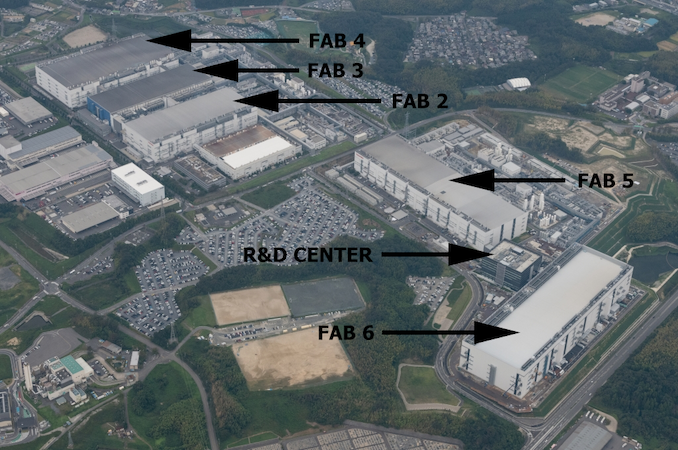Toshiba & WD NAND Production Hit By Power Outage: 6 Exabytes Lost
by Anton Shilov on June 28, 2019 12:15 PM EST
Toshiba Memory and Western Digital on Friday disclosed that an unexpected power outage in the Yokkaichi province in Japan on June 15 affected the manufacturing facilities that are jointly operated. Right now, production facilities are partially halted and they are expected to resume operations only by mid-July.
Western Digital says that the 13-minute power outage impacted wafers that were processed, the facilities, and production equipment. The company indicates that the incident will reduce its NAND flash wafer supply in Q3 by approximately 6 EB (exabytes), which is believed to be about a half of the company’s quarterly supply of NAND. Toshiba does not disclose the impact the outage will have on its NAND wafer supply in the coming months, but confirms that the fabs are partially suspended at the moment. Keeping in mind that Toshiba generally uses more capacity of the fabs than WD, the impact on its supply could be significantly higher than 6 EB with some estimating that it could be as high as ~9 EB.
Both companies are assessing the damage at the moment, so the financial harm of the incident is unclear. Not even counting potential damage to production tools and other equipment used at the fabs, 6 EB of NAND cost a lot of money. Furthermore, analysts from TrendForce believe that a consequence of the outage will be some loss of confidence from clients of both companies, which will have a financial impact as well.
The Yokkaichi Operations campus jointly owned and run by Toshiba and Western Digital produces about 35% of the global NAND output in terms of revenue, according to TrendForce. At present, the manufacturing base has five production facilities (Fab 2, Fab 3, Fab 4, Fab 5, and Fab 6) as well as an R&D center, all of which were affected by the outage. Three fabs within the campus produce 3D NAND flash, whereas another two are used to make special-purpose types of memory.
Considering the gargantuan size of the Yokkaichi Operations, disruptions of its supply will inevitably have an effect on 2D NAND and 3D NAND spot prices in the short-term future. Nonetheless, since contract prices have already been set for Q3 (and possibly Q4), they are not going to change. Meanwhile, it remains to be seen whether large customers will have to go shopping in Q3 or Q4 and affect prices on the spot markets further.
Considering that the Yokkaichi Operations produces at least 1/3 of the global NAND flash output (let’s assume that dollar share more or less corresponds to bit share) and half of its production for the quarter was lost because of the incident, this means that the industry will miss approximately 1/6 (or 16.5%) of the global NAND supply in Q3. Whether or not this will create a deficit on the market that will cause significant price hikes depends on multiple factors and is something that remains to be seen.
Related Reading
- Toshiba Memory and Western Digital Open Fab 6 and New Memory R&D Center
- Toshiba Memory & Western Digital Finalize Fab K1 Investment Agreement
- Toshiba Begins to Construct New BiCS 3D NAND Fab in Iwate Prefecture
- Toshiba Memory to Build New Fab to Produce BiCS 3D NAND
- Toshiba Finalizes Plans for New 3D NAND Fab: Coming Online in 2019
- Toshiba to Build New Fab to Produce BiCS NAND Flash
Sources: Western Digital, Reuters, TrendForce, Blocks & Files












148 Comments
View All Comments
azfacea - Friday, June 28, 2019 - link
wow a fab that gets destroyed for 3 months by a power outage lol. darwin award well deservedV900 - Friday, June 28, 2019 - link
Little harsh there! We have no idea what caused the outage, who was responsible or if it could have been prevented.Skeptical123 - Friday, June 28, 2019 - link
"unexpected power outage in the Yokkaichi province" These fab are some of the most sophisticated and costly factories in the world. A simple loss of grid power is by far one of their easiest issues to mitigate and is done so with if possible multiple power pant connections, batteries, and diesel generators. This is standard practice at facilities that cost a fraction of these chips fabs. As such regardless of the reason heads will rollFunBunny2 - Saturday, June 29, 2019 - link
"easiest issues to mitigate and is done so with if possible multiple power pant connections, batteries, and diesel generators."does "too big to fail" strike a familiar note? just because a company could build out sufficient back up power supply for a campus doesn't mean it's smart to do so. balanced against the cost of the back up supply is the expected occurrence of demand. IOW, if such a power loss was/is believed to be a once in a decade or more event, then the loss of product spread over that decade may be far less than the amortized cost of the back up supply. the engineers and bean counters decided that cost exceeded the probability. what matters is the actual cause, and why the event occurred. it may be that the event was within the designed probability envelope, and the companies are OK with the outcome.
azfacea - Saturday, June 29, 2019 - link
OMG the siliness in this thread is out of control. Dude power loss is NOT a once in a decade event in japan. This is clearly a design failure. Dude stop pretending these fabs drew more power than half the country. Dude aircraft carriers have onboard power. Some clown actually said "there may not have been enough space in japan" these fabs cost more than aircraft carrier to build. are u seriously saying they didnt think about power outage when designing this? if thats the case every semiconductor should have multiple fabs out every year.My brain is about boil at the sheer number of ppl and magnitude of stupidity in this thread. I am truly amazed at the number of ppl who can be this far out in cartoonland. I was wondering how can a whole country be stupid enough to fall for something like a bolshevik revolution. now i know.
PeachNCream - Sunday, June 30, 2019 - link
It's ironic that someone who cannot consistently operate the shift key or type the word "people" in order to communicate effectively is losing it over the supposed stupidity of others. That's a lovely glass house you're living in over there, dude.FunBunny2 - Sunday, June 30, 2019 - link
Dude, the issue is whether the cost/benefit analysis of a back up supply robust enough to save the campus *of this magnitude* (modified by the expectation of such an event) wasn't done or was ignored. As reported, there was a back up supply, just not one robust enough to last 13 minutes. You may not remember the Great Northeast Blackout, but I lived through it. Should every town have had a backup power plant? Holyoke did, in that the municipal plant was off-grid, so wasn't taken out in the cascade. Good planning or good luck?Samus - Monday, July 1, 2019 - link
This comment is spot on.This likely has nothing to do with grid power. See that small building to the Northeast. That's a power distribution facility. The problem occurred somewhere between there and the campus buildings, because billion dollar sites like this produce their own backup power in real time.
JanW1 - Monday, July 1, 2019 - link
This likely has nothing to do with technical reasons at all."Western Digital Corp. shares logged their best weekly gain in nearly seven years Friday as investors considered a power outage at one of the digital storage device maker's flash memory production facilities to be good news given the glut in memory chip inventories."
'Nuff said.
eva02langley - Monday, July 1, 2019 - link
We are talking about extreme power usage here. There is no backup for that.